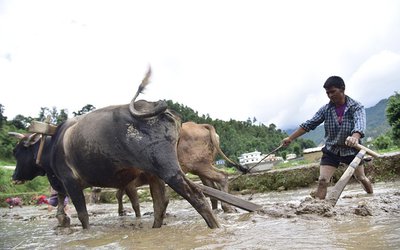More on National






Few years ago during the heydays of real estate growth, the Vibor management was looked up as an example of innovation. Their investment spree in lucrative real estate was returning huge profit that made others salivate.
Today, the same people are criticizing the bank management for their failure to read the writing on the wall.
As a national level development bank, Vibor had been gaining credibility. But the last week’s turn of events show how fragile their situation always was.
“It is quite clear that most of their credit investments were on real estate sector – up to 60 percent. And they were managing day-to-day liquidity by the deposits from a handful of big depositors. Once those deposits were withdrawn, they went bust,” said a source at the central bank.
It was after the Nepal Rastra Bank (NRB) decided not to renew its fixed deposits of Rs 270 million followed by the decision of Nepali Army (NA) to save its deposits that the Vibor had to run for cover.
“It was during the time when the US economy became crisis-ridden due to burst in real estate that BFIs in Nepal were on a rush to invest in lands. The Nepali bankers, too, should have calculated the possible risks. They did not,” said an economic analyst.
The Vibor management does not agree. In their website they have posted an information stating that only 22.62 percent of their credit is invested in real estate.
For the time being though, the NRB’s decision to provide Rs 500 million worth refinancing by acting as lender of the last resort has stabilized the condition of Vibor and it has already started collecting individual deposits as well. But is the problem solved?
No, say most bankers and analysts.
Crunch of Liquidity
“In my banking career spanning almost three decades, I have never seen this kind of liquidity crunch,” the remarks of Ashok Rana, president of Nepal Bankers’ Association, sums up the severity of the crisis.
And there are multiple reasons for such a crunch. First and foremost is the continuing political instability that has hurt the smooth implementation of budget. As around Rs 30 billion of the government’s fund still lies unutilized due to its inability to carry out development works, the market has remained squeezed.
“The budget must come on time and be implemented for this crisis to be resolved once and for all,” says Rana.
On the other hand, huge chunk of BFIs’ money are locked up in real estate investments. As they see the property prices falling, nobody is willing to sell them off at a loss for the time being.
This also has added to liquidity problem. Writes former finance secretary Rameshwore Khanal, “One thing is sure, land prices will not rebound to the level seen at the peak of the property market boom a year and a half ago. The current problem is due to adamant behavior by market players holding on to the same prices, thus freezing much of the liquidity that the market could generate.”
The real estate agencies have been saying that following the decision by the central bank asking the BFIs to reduce their exposure to the real estate (the BFIs have been asked to bring down their real estate credit to below 25 percent of total credit within mid July this year), they have witnessed a free fall. “Transactions have decreased by almost 90 percent,” say the agencies.
And that trust is not going to be restored anytime soon.









